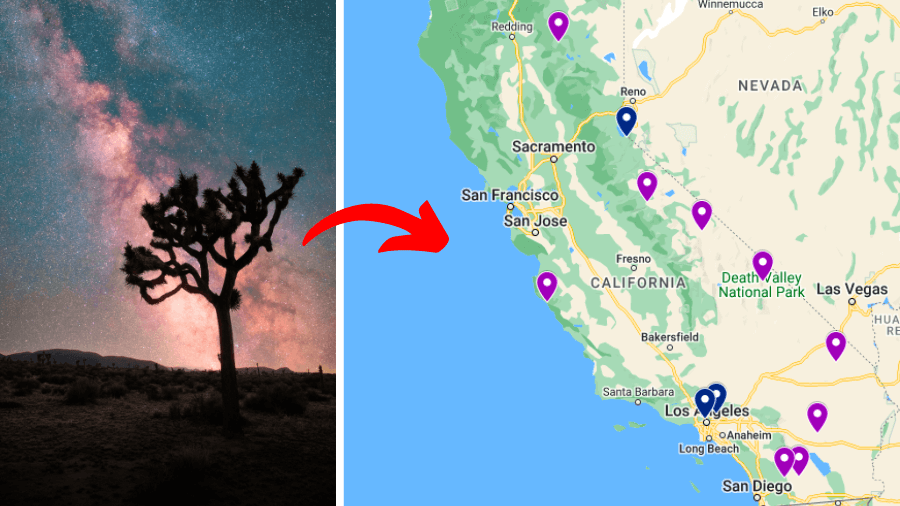Ready to chase stars in California?
We’ve got the ultimate list of places where the night sky isn’t just dark, it’s dazzling.
Think of deserts that whisper secrets to the stars and mountains that brush the edges of the Milky Way.
Get ready for some serious starry nights.
We’ll start with our list of 9 ‘top dog’ places for stargazing in California and we’ll end the list with some ‘honorable mentions’ that didn’t quite make the cut for the main list.
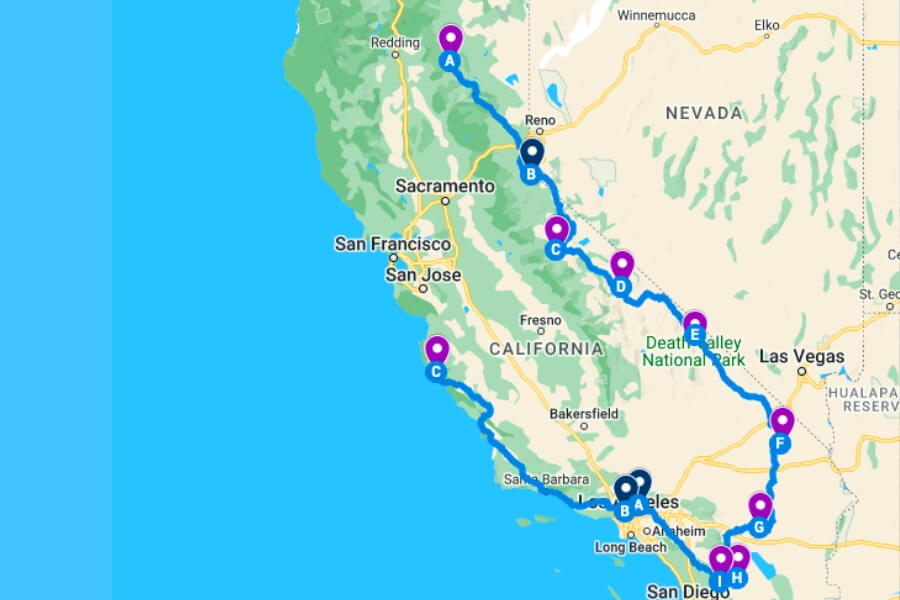
The Best Stargazing Spots In California
Starting off in no particular order….
1. Death Valley National Park
Death Valley National Park stands as a premier destination for stargazers.
Designated as an International Dark Sky Park, it offers some of the darkest nights in the United States, making it an ideal location for observing stars.
The park’s vast, open landscapes provide unobstructed views of the night sky, allowing for spectacular sightings of galaxies, nebulae, and meteor showers.
Stargazing here is particularly exceptional during the new moon, when the sky is at its darkest.
Enthusiasts often gather at Harmony Borax Works or Mesquite Flat Sand Dunes for optimal viewing experiences.
The best times to visit are generally the winter and spring months, when clear skies are more common and the temperatures are more comfortable for nighttime observations.
Annual events like the Death Valley Dark Sky Festival, typically held in the spring, offer guided stargazing, astronomy talks, and telescope viewing, making it a not-to-miss event for astronomy enthusiasts.
2. Joshua Tree National Park
Joshua Tree National Park is a perfect place for stargazers, where the Milky Way stretches across the sky on clear nights.
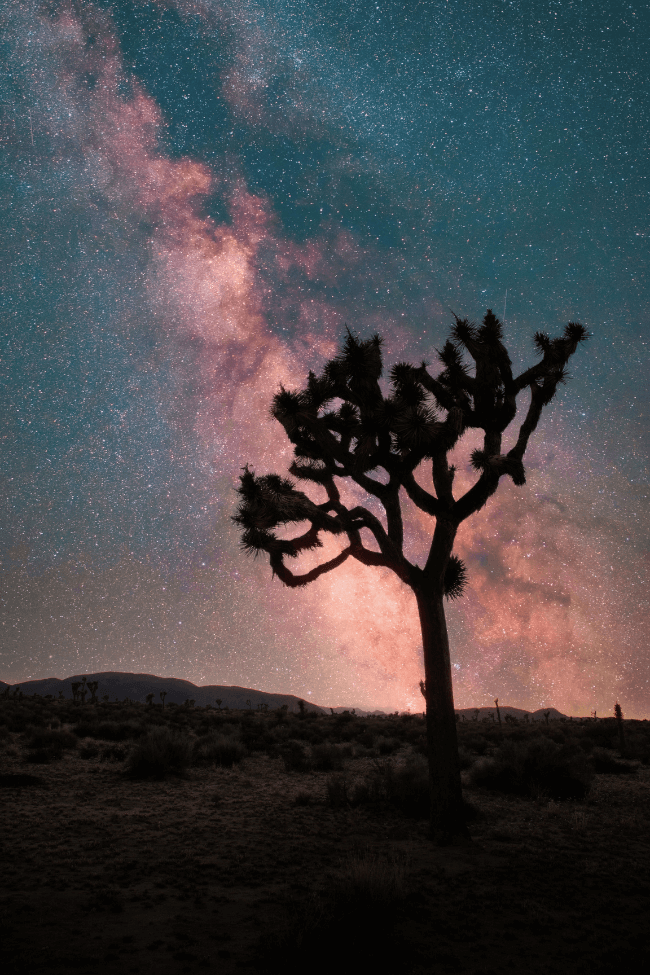
Renowned for its minimal light pollution, the park’s rugged landscape of desert plains and unique Joshua trees adds a magical backdrop to the celestial display.
Visitors often find themselves mesmerized by the clarity of constellations, planets, and meteor showers visible here.
Popular spots within the park for night sky observations include Skull Rock and Keys View, offering panoramic views of the heavens.
The park is best for stargazing from March to September when the ‘core’ of the Milky Way is visible.
If you want to take the thinking out of the equation, then there are some highly rated tours like the one linked below:
Joshua Tree also hosts night sky programs and astronomy events, providing educational and awe-inspiring experiences for both amateur and seasoned astronomers.
3. Anza-Borrego Desert State Park and Borrego Springs
Anza-Borrego Desert State Park, together with the Dark Sky Community of Borrego Springs, provides a spectacular stargazing sanctuary.

This area is celebrated for its commitment to dark skies, with Borrego Springs being one of the few Dark Sky Communities in the world.
The park’s expansive desert terrain and distant location from major cities allow for uninterrupted views of the star-filled sky.
Popular among amateur astronomers, the park offers numerous locations like Fonts Point and the Visitor Center for setting up telescopes and enjoying the night sky.
The best times for stargazing are during late winter and early spring, but generally has good skies all year round.
The annual Borrego Springs Dark Sky Party is a highlight, drawing enthusiasts for night sky photography, telescope viewing, and astronomy talks.
4. Yosemite National Park
Yosemite National Park offers some of the most breathtaking stargazing experiences in California.
Its high altitude and clear mountain air provide exceptionally crisp views of the night sky.
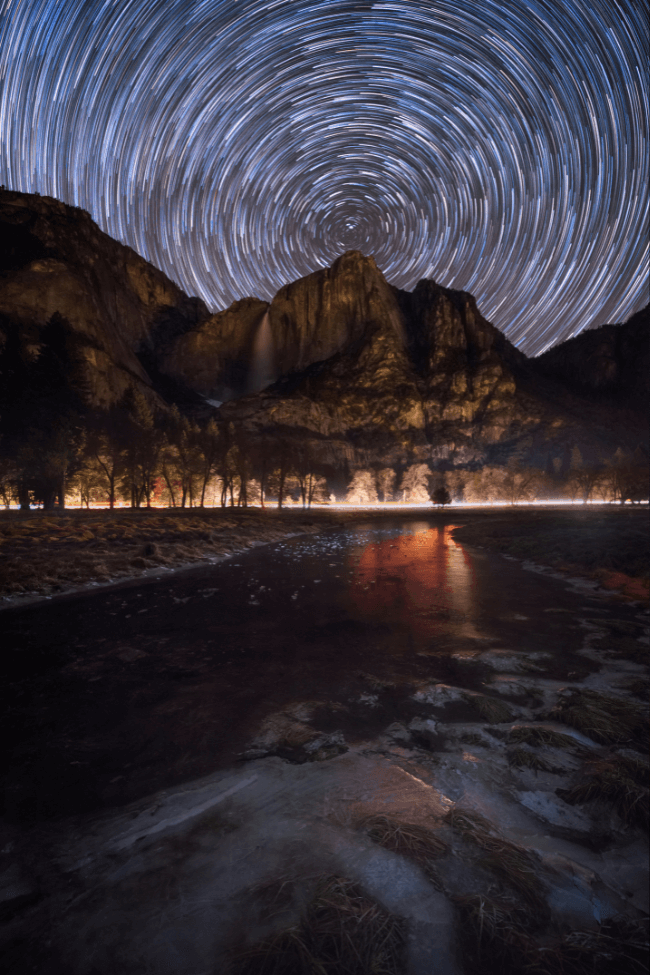
The park’s iconic granite cliffs and towering sequoias create a majestic backdrop for viewing constellations, planets, and meteor showers.
Glacier Point and Olmsted Point are among the favorite spots for astronomers, offering panoramic views of the sky and minimal light interference.
The optimal time for stargazing in Yosemite is during the summer and early fall, when the skies are often clear and the park is more accessible.
Yosemite also hosts astronomy programs and star parties, particularly in the summer, enhancing the stargazing experience with guided sessions and educational talks.
5. Lassen Volcanic National Park
Lassen Volcanic National Park is a hidden gem for stargazing enthusiasts.
Its remote location and high elevation result in some of the darkest and clearest skies in California.
The park’s diverse landscape, dotted with volcanic features and mountainous terrain, adds to the uniqueness of the stargazing experience.
Bumpass Hell and Manzanita Lake are popular spots within the park for night sky observations, offering stunning views of the Milky Way and other celestial phenomena.
The best time to visit for stargazing is during the summer and early fall months when the weather is milder and the skies are clearer.
Lassen Volcanic National Park also organizes annual starry night festivals, providing guided stargazing, astronomy talks, and telescope viewing, making it a perfect destination for both amateur stargazers and experienced astronomers.
6. Big Sur
Big Sur, with its dramatic coastline and minimal light pollution, offers a unique stargazing experience by the sea.
The expansive ocean horizon and the rugged cliffs provide a serene and awe-inspiring setting for observing the night sky.
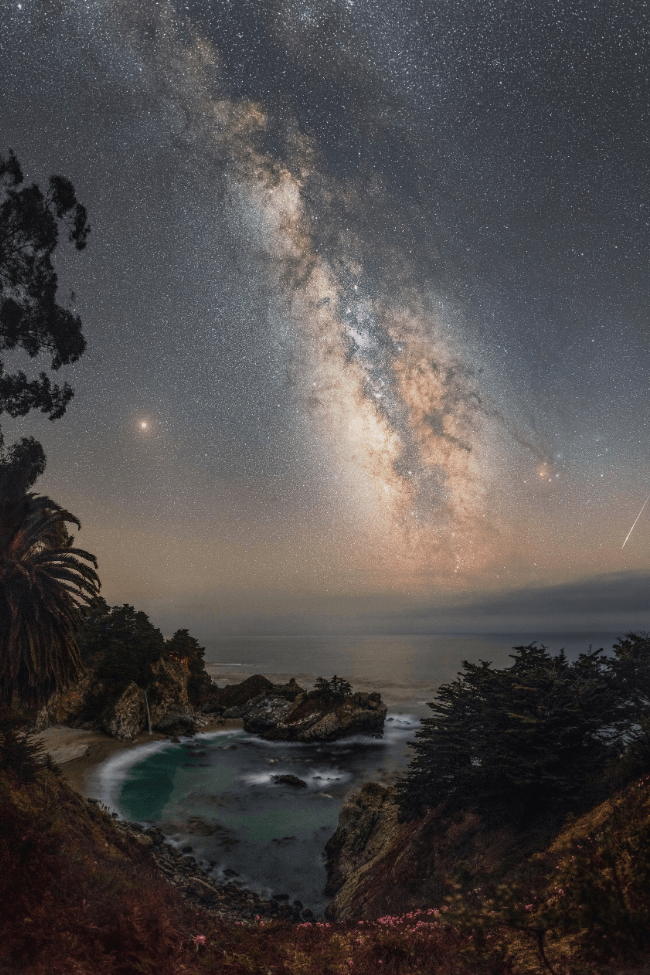
Stargazers can enjoy unobstructed views of the Milky Way and frequent meteor showers, particularly at spots like Pfeiffer Beach, Prewitt Ridge, McWay Falls and Andrew Molera State Park.
The lack of urban development along the Big Sur coastline ensures darker skies, making it ideal for astronomical observations.
The best times for stargazing in Big Sur are during the late summer and fall months when the coastal fog is minimal, and the skies are clearer.
Big Sur’s natural beauty and tranquil nights create a perfect atmosphere for both casual stargazing and serious astronomical pursuits.
7. Mojave National Preserve
Mojave National Preserve is a stargazing haven in the heart of the desert.
Its vast, open landscapes far from city lights create an ideal setting for spectacular night sky views.
The preserve’s high desert terrain allows for expansive views of celestial events, star clusters, and the Milky Way.
Popular locations within the preserve for night sky observations include Kelso Dunes and Hole-in-the-Wall, offering a panoramic sky view.
Stargazing is particularly remarkable here during the new moon phase, when the darkness of the night sky is at its peak.
The best period for stargazing in Mojave National Preserve is from late fall to early spring, when the night skies are clearest and the temperatures are better for nighttime observations.
The preserve occasionally hosts night sky programs, making it a great destination for those looking to deepen their understanding of astronomy.
8. Julian, San Diego
Julian, a designated Dark Sky Community nestled near San Diego, offers a serene stargazing experience away from the city’s light pollution.
This charming mountain town is committed to preserving the night sky, making it a hidden gem for astronomers and casual stargazers alike.
Its elevation and clear skies provide excellent conditions for viewing constellations, planets, and meteor showers.
Popular stargazing spots in Julian include the areas around Lake Cuyamaca and the Volcan Mountain Wilderness Preserve.
The best times to visit Julian for stargazing are during the summer and fall months, when the skies are clearest.
The town also hosts various stargazing events throughout the year, adding to its appeal as a prime location for night sky enthusiasts.
If you’re visiting in August you can also attend the Julian Star Fest.
9. Owens Valley
Owens Valley offers a spectacular yet lesser-known stargazing haven in California.
Nestled between the Sierra Nevada and the White Mountains, its remote location ensures some of the darkest skies in the state.
The high altitude here not only brings cooler temperatures but also clearer skies, perfect for night sky photography and deep sky observations.
The Owens Valley Radio Observatory adds a scientific touch, highlighting the area’s significance in astronomical studies.
Popular spots for stargazing include the areas around Bishop and the scenic Alabama Hills, where the silhouettes of the mountains frame the star-filled sky.
The best time to visit Owens Valley for stargazing is during the summer and fall, when the weather is mild and the skies are typically clear.
Its serene and unspoiled landscapes make it an ideal destination for those seeking a tranquil space to connect with the cosmos.
Honorable Mentions
These places aren’t terrible, but they’re just not quite as good as the main list.
So these places are still worth a visit for different reasons.
There’s probably a lot more places we can add to this list so we’ll update it over time.
1. Mount Wilson Observatory, Los Angeles
Mount Wilson Observatory, located near Los Angeles, is renowned for its historical significance in astronomy.
While it offers educational tours and telescopic viewings, its proximity to the city results in considerable light pollution.
This diminishes the quality of stargazing compared to more remote locations, placing it as an honorable mention.
Ideal for daytime visits and learning about astronomy’s history, it’s less suited for experiencing pristine night skies but a decent and accessible family day out.
2. Griffith Observatory, Los Angeles
Griffith Observatory, set in the hills of Los Angeles, is a popular educational and cultural landmark.
It provides telescopic viewing and astronomy exhibits, yet faces significant urban light pollution.
This urban setting limits the stargazing quality, making it more suitable for educational purposes than for optimal night sky observation.
It’s an honorable mention due to its accessibility and educational value, despite the compromised stargazing conditions.
3. Lake Tahoe
Lake Tahoe, known for its stunning natural beauty, offers enjoyable stargazing experiences.
However, light pollution from nearby tourist areas and ski resorts affects the clarity of the night sky.
While it presents decent stargazing opportunities, its ambient light levels are higher compared to more secluded spots.
Lake Tahoe earns its place as an honorable mention for its combination of natural beauty and accessible stargazing.
General Tips for Stargazing in California
To get the most out of your stargazing experience you want to make sure you follow some important tips.
Best Times of Night
After Sunset: Not the best. ❌
The period just after sunset, known as twilight, offers a beautiful sky but is usually not dark enough for optimal stargazing.
Late Evening to Midnight: GOOD ✅
This time is often considered ideal for stargazing, as the sky is darkest, especially during a new moon or when the moon is below the horizon.
Pre-Dawn Hours: GOOD ✅
Great for observing different constellations and planets not visible earlier in the night.
Best Times of Year
Spring and Fall
These seasons provide clearer skies with less atmospheric disturbance compared to summer and winter.
Meteor Showers
Specific times of the year are better for viewing meteor showers, like the Perseids in August or the Geminids in December.
Summer
Summer is one of the best times to see the Milky Way in the Northern Hemisphere (which California is in).
If the specific location you want to visit has clear skies and comfortable temperatures then this can be a decent time to go.
Moon Cycle
New Moon ✅
The best stargazing conditions are during a new moon when the sky is darkest.
First and Last Quarter Moon
These phases offer good stargazing opportunities, particularly for moon observation.
Full Moon
A full moon brightens the sky and can make it harder to see stars and other celestial objects.
Choosing the Right Location
Away from Light Pollution
Locations far from city lights, like dark sky preserves or remote areas in national parks, are ideal.
Elevation
Higher elevations, such as in the Sierra Nevada, can offer clearer skies.
Equipment and Preparation
Binoculars/Telescope
Not necessary but can enhance the experience. Binoculars are a good start for beginners.
Star Map or App
Helpful in identifying constellations and planets.
Comfort and Safety
Bring warm clothing, a blanket, and a red-filtered flashlight to preserve night vision.
Weather and Astronomical Conditions
Always check the weather forecast and astronomical conditions like moon phases and meteor showers before planning your stargazing adventure.

